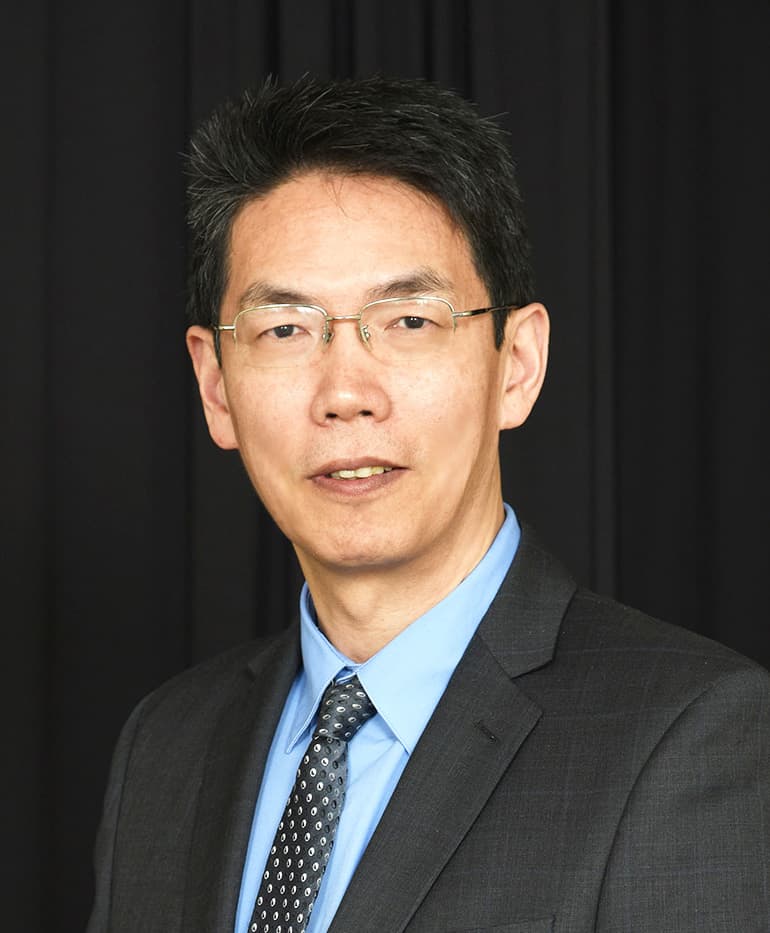
NERS Department Merit Award Talk

Jian Gan
2024 Michigan Engineering Department Merit Awardee for NERS
Directorate Fellow and Scientific Lead for Advanced Characterization, Idaho National Laboratory
Friday, September 13, from 12–1:30pm
Baer Room, 2906 Cooley
Abstract
Advanced Characterization Capabilities at INL
Advanced characterization of radiation effects in nuclear fuels and reactor structural materials is crucial to help understanding the material property changes under irradiation. Microstructural evolution at nanoscale could strongly affect the material performance on macroscale. Radiation-induced material degradation includes dimensional instability, cavity formation and void swelling, fuel restructuring and elemental redistribution, phase change, precipitate formation, hardening and embrittlement, intergranular cracking, radiation-enhanced chemical interaction at the interfaces like FCCI, and radiation-assisted stress corrosion and cracking (IASCC). To mitigate the radiation damage, advanced characterization on irradiated microstructure, microchemistry, micromechanical property is necessary to identify the controlling mechanisms that are responsible to the materials degradations.
Idaho National Laboratory (INL) has been in rapid growth over the last 10 years. This presentation provides an overview of the INL with focus on the advanced characterization capabilities in support of nuclear energy research at the Materials and Fuels Complex (MFC). It highlights the recently established R&D capabilities at the Irradiated Materials Characterization Laboratory (IMCL). Some examples on advanced characterizations on irradiated fuels and structural materials will be presented. IMCL demonstrates the power of combining sample preparation of highly radioactive materials with capabilities of micromechanical testing and microstructural characterization down to atomic resolutions within one facility. A brief introduction of the new Sample Preparation Laboratory (SPL) will be included in the presentation.
Biography
Jian Gan, Ph.D., has been a Directorate Fellow at Materials and Fuels Complex directorate, Idaho National Laboratory since 2017. He is currently the Scientific Lead for Advanced Characterization in the Characterization and PIE Division. He was the Deputy Director of the Center for Thermal Energy Transport under Irradiation (TETI), one of the DOE’s Energy Frontier Research Centers (EFRC) led by INL. He was the department manager for 7 years (2015-2021) responsible for Advanced Characterization Department on characterization of nuclear fuels and materials for various programs. He has been working as Principal Investigator (PI) and work package manager on numerous projects including as a lead PI on a BES core project at INL since 2017. His research focuses on radiation effects in materials and fuels and characterization of microstructural evolution under irradiation from neutrons, protons and heavy ions using TEM. He has authored and co-authored 142 technical papers. Dr. Gan has been with INL since January 2002. He did his post-doctor fellowship at Pacific Northwest National Laboratory from 1999 to 2001. He earned his M.S. and Ph.D. degree in Nuclear Engineering from the University of Michigan in 1994 and 1999, respectively, and a B.S. and M.S. degree in Physics from Fudan University in 1982 and Central Michigan University in 1992, respectively. He was an assistant professor (1982-1987) and a lecturer (1987-1990) in the Department of Physics at Fudan University in China before he came to the U.S. in 1990. He has been a member of the Expert Working Group on Innovative Structural Materials with Nuclear Science Committee of OECD-NEA since 2013.
2023 Eric Esarey

Friday, September 22, 2023, 1:30 PM
Cooley Baer Room
2023 Michigan Engineering Department Merit Awardee for NERS
Director BELLA Center
Lawrence Berkeley National Laboratory
Abstract
This talk will summarize the current activities of the BELLA Center on laser-plasma accelerator (LPA) research and applications. This will include a description of the newly commissioned extensions to the BELLA PW laser, namely the second beamline (2BL) and the interaction point two (IP2) beamline and target chamber [1]. 2BL provides a second beamline to the interaction point one chamber, along with the first beamline, where experiments are done on LPAs. The primary objectives are experiments on laser-generated plasma channels to yield electron energies near 10 GeV, and the high efficiency staging of LPA modules at the multi-GeV level. IP2 provides a new short focal length capability to provide ultrahigh laser intensity for experiments on ion acceleration and high energy density science. The BELLA Center also houses two independent 100 TW lasers that are used for a wide variety of studies, including x-ray generation by Thomson scattering and LPA-driven free electron laser research. Also discussed will be the development of fiber lasers that use coherent combining in both space and time to enable high average power at kHz repetition rates and beyond.
![Schematics of the BELLA PW facility [1] showing new 2BL and iP2 beamlines.](https://ners.engin.umich.edu/wp-content/uploads/sites/9/2023/08/Screen-Shot-2023-08-28-at-11.20.59-AM-1024x439.jpg)
References
[1] K. Nakamura et al., Journal of the Particle Accelerator Society of Japan 19, 205 (2023).
Funding Note
Work supported by U.S. Department of Energy Office of Science, Offices of High Energy Physics and Fusion Energy Sciences, under Contract No. DE-AC02-05CH11231, and LaserNetUS (www.lasernetus.org).
Brief Biography
Dr. Eric Esarey is the Director of the Berkeley Lab Laser Accelerator (BELLA) Center at Lawrence Berkeley National Laboratory (LBNL). He received the Ph.D. degree in plasma physics from the Massachusetts Institute of Technology in 1986 and the B.S. degree in nuclear engineering from the University of Michigan in 1981. He worked at the Naval Research Laboratory from 1986 -1998 and join LBNL in 1998. Dr. Esarey has published over 300 refereed journal articles on intense laser interactions with electron beams and plasmas, advanced acceleration concepts, novel radiation sources, and related fields. He is a recipient of the 2010 John Dawson Award for Excellence in Plasma Physics Research from the American Physical Society, the 2018 Advanced Accelerator Concept Prize, and the 2019 Directors Award for Exceptional Achievement from LBNL. Dr. Esarey was elected a Fellow of the American Physical Society in 1996, “In recognition of his seminal scientific contributions to the physics of intense laser-plasma interaction.”